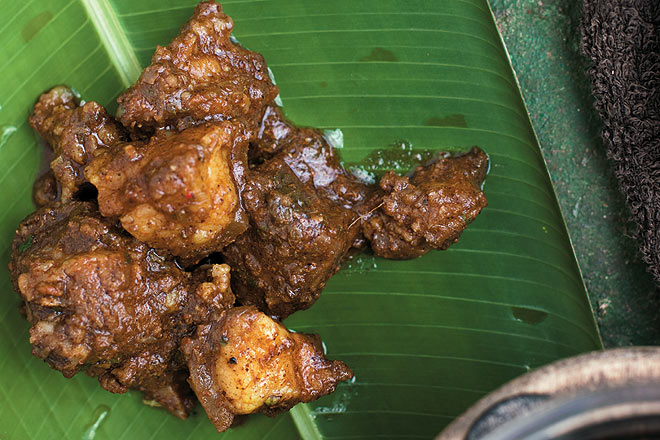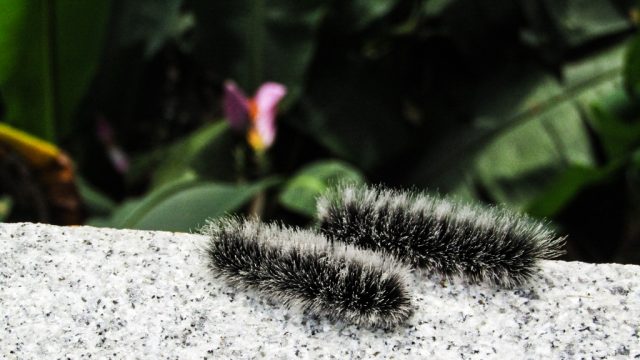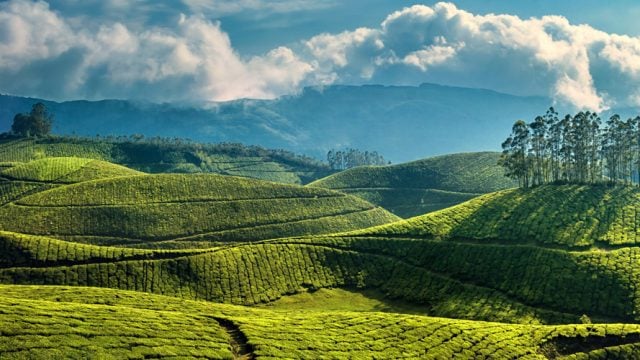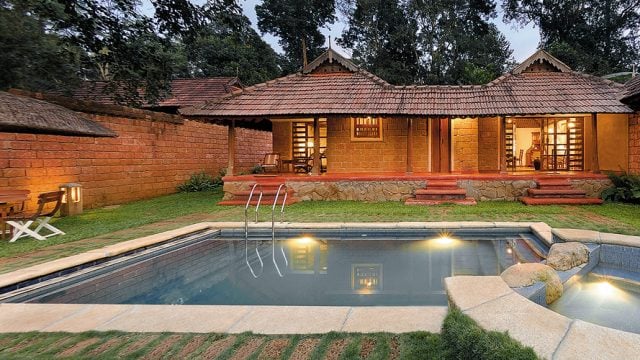Driving around Coorg, it’s easy to lose one’s bearings. The district is essentially
Arriving at these bungalows, the overwhelming feeling is one of seclusion. You may be able to see the mountain ranges in the distance or have a view of coffee buds in bloom but very rarely on plantations in Coorg can you spot your immediate neighbour, should one exist. This cut-off-from-the-world feeling is what everyone comes to Coorg for. And well-travelled and sociable as the Kodavas are, it is the rhythms of the seasons and the produce of the land that continue to define Kodava food.
The centrepiece of this cuisine is meat and its underpinning is rice. The coffee plantations were a nineteenth-century British enterprise; before that it was rice that ruled the land. “The wealth of our ancestors was paddy and cattle,” says coffee planter Madan Somana, who with his wife Anita runs the BB Estate Homestay in Kadagadal (9448167277, bbestatehomestay.com). The paddy fields needed protection from predators such as wild boars which were often shot down and then eaten, says Madan as an explanation for the origin of that prince of Kodava dishes, pandi curry — succulent pork cubes coated in a tangy, smooth and very dark masala.
Pandi has come to represent the specialness of Kodava cuisine — not only because it is one of those rare South Indian pork dishes but also for its unique taste. Pandi is tantalising partly because the dry spices used in it — pepper, coriander and cumin among them — are roasted before they are ground, giving the gravy a deliciously toasty flavour. The other vital factor is kachampuli, a local fruit that is inedible in the raw, but pulped and thickened creates a condiment that has a shelf life of a dozen years or more, adds that crucial pungency to the meat, helps to preserve it, fights cholesterol and zaps the nasty creatures that sometimes set up home inside pigs.
Pandi is hard to resist and difficult to get outside Coorg. Anita says that many of her guests clamour for it; Kodavas visiting the homeland after long inevitably do. She sometimes tries variations such as chilli pork for a change. Her pandi is enticing; the dry chilli pork she has made alongside is good but doesn’t have a chance against its addictive, traditional relative. Among bowls of koli (chicken) and kuru (beans) curries, in which, unlike pandi, coconut is an essential ingredient, Anita has set out a plate of another rarity — tender bamboo shoot or baimbale. This seasonal vegetable is soaked in water over three days in order to ferment it and then usually seasoned with mustard seeds, curry leaves and red chillies, letting the sourness and juiciness of the shoots dominate.
As for paddy, even though the Kodavas do not grow very much of it any more, they continue to honour those rice-eating traditions of old — pouring thin chicken curry over the rice noodle-like nool puttu, turning out delicious rice-and-coconut cakes called pa-puttu, and insisting that pandi curry only be eaten with kadambuttu (small, firm balls of steamed rice). Their rotis are akki (rice) ootis; their standard dessert payasa is broken rice cooked in coconut and jaggery; and Kodava snacks, such as badokajaya and chikkalunde, are, inevitably, made of rice flour.
At the Tata-owned Cottabetta Bungalow in Pollibetta (080-23560761, plantationtrails.net), chef Girish, who is from neighbouring Hassan district, is handing me some freshly-plucked leaves. We have just eaten a meal of fantastic pandi, the spices perfectly balanced with the meat, along with chicken curry, nool puttu, kadambuttu and a lovely dish of stir-fried black-eyed beans and horse gram called usli. I am enquiring of Girish about Kodava vegetarian cuisine. “This is called harive soppu,” he says about the leaves. “Grows in the wild. We cook it into a vegetable.” He forays into the garden a second time to get a small chakke (jackfruit) for photographer Jyothy who wants to see how it might look placed alongside the bowl of cooked chakke, which was also part of lunch. (It’s jackfruit season; everywhere on the drive we spot the pendulous fruit hanging heavy on trees. We’ll encounter it on many tables.)
This breaking off conversation to get something to show from the garden will run through the course of the trip — a wonderfully spontaneous gesture that says a great deal about how organic the Kodavas’ relationship with eating and cooking continues to be. At Alath-Cad (9449617665, 9611521081, alathcadcoorg.com), where the food is arguably the best to be had anywhere in Coorg, there are fruit trees on the estate and the vegetables on Mrs Muddaiah’s table are seasonal and, again, occasionally wild. It is here that we taste the sublime kaad mangia (wild mango) curry made from the fruit of a tall species that is gathered only when it falls to ground, the tree being hard to climb. The fruit is sweetened with jaggery and cooked in many of the same dark spices that pandi is. The result is sweet and sour heaven. In between sharing recipes with me for her wonderful koli barthad (chicken fry, another Kodava staple), as well as a rice and coconut milk sweet called halbai, Mrs Muddaiah sends for some leaves from her allspice tree, which she uses to season biryanis with, and shows me the tiny, locally grown green chillies that they prefer to the commoner variety.
The innovative use of local ingredients is further evident in the many chutneys of Coorg. The seeds of the jackfruit are boiled and worked into a chutney with coconut and lots of lime — a seasonal breakfast accompaniment to akki ottis, as is a marvellous chutney made of kaipuli (or bitter orange, yet another wild fruit), which we will later sample at Palace Estate in nearby Kakkabe.
In southern Coorg, at Irpu Resort (9448475222), which is no resort at all but the spacious home of the regal and friendly Vanita Bhimmiah, among the tureens of delicious pandi and koot (vegetable) curry at the table, there is a small bowl of another green that grows in the wild — kakey toppu. “I don’t know if you’ll like it, it can be bitter. We use it to treat colic in children and it’s also great for the health of pregnant women,” says Vanita. I cannot picture this elegant woman tramping in the wild in search of a few edible leaves but the fact is that she single-handedly manages two coffee plantations; it is clear from her enthusiasm for things like colocasia and her remarks about wild mangoes and bitter oranges that she is closely attuned to forest life. She brings out a bottle of kachampuli to show us and describes the painstaking process of making it; most buy this precious and expensive ingredient readymade nowadays.
Vanita lives alone on her plantation for most of the year and at some point in our conversation uncovers a double-barrel shotgun that has thus far been lying innocuously in a corner. She strikes an impressive pose with the twelve-borer but confesses to never having had occasion to use it. While the Kodavas have, since the mid-nineteenth century, the freedom to carry firearms in the district without a licence, and while many still live a life their ancestors would recognise, it has to be said that there doesn’t seem to be much wild boar left to hunt. In fact, Mrs Muddaiah of Alath-Cad gets hers from Bangalore’s famous Ham Shop; it travels the 250 kilometres on an AC bus!
Prasad and Vincy Apparanda run Palace Estate (9880447702, palaceestate.co.in), the scenic plantation and homestay located at the foot of Tadiyendamol, the highest peak in Coorg. Prasad and Vincy are the youngest of the planter couples we meet on this trip; yet they seem as, if not more, aware as the others about the traditions of their community and the ways in which these are changing. We have heard about the harvest festival and the one dedicated to the worship of the river goddess Kaveri. At Palace Estate we learn about the lesser known Kakkada Padinett, a ritual plucking of a wild leaf called madd toppu (‘medicine leaf’) which blooms for only a couple of days in August. The water in which it’s boiled is used to cook rice in or eaten with honey. Vincy sticks to tradition even with the food — her yummy chicken fry and rich nai kool (ghee rice) are cooked on a wood fire, and she shares recipes with us for rare Kodava delicacies such as kuvale putt — the flesh of a tender jackfruit mixed with broken rice and steamed in a banana leaf.
Then Jyothy asks Prasad what his favourite food is and he says he’s often happy with rice, dal and pickle. His answer reminds me of what I have noticed through the trip: the Kodavas themselves don’t eat a great deal of the food that they are famous for. Mrs Muddaiah of Alath-Cad talked of chapatis made of wheat and soya flour and Anita Somana said that her dinner is often soup with brown bread. Even at a little shack called Hotel Shahidiya (8777560773; meal for two Rs 200) on the Madikeri-Mangalore highway, where they make a fire-breathing chicken curry, the owner declares that it doesn’t agree with him and he much prefers chapatis and vegetables.
While health concerns have distanced the community from its rice- and meat-rich diet, gluttonous tourists and homesick Kodavas continue to keep the cuisine alive. One looks forward to a time when there is a larger restaurant culture around Kodava food. At the moment there are only two restaurants serving Kodava food in Madikeri town. Madikeri’s best is Folksy Food (Hotel Caveri Comforts, near Janata Bazaar, 9448711459; meal for two Rs 250) run by Mr Lipton. His wife, Leelavati, is a star cook — starting with her always delicious pandi and down to the perfect rasam. A meal at Folksy Food starts with a conversation about what’s cooking and proceeds to the partaking of a meal that unerringly tastes of home. They make the non-vegetarian standard of pandi and chicken curry but one must definitely try the vegetarian dishes too. The koot curry of the day — a mix of vegetables in a toor (arhar) dal base — as well as the daily side dish of dry vegetable is always excellent. Coorg Cuisine (Madikeri Main Road, opposite Post Office, 9449699864; meal for two Rs 350) has more of a restaurant ambience and a full menu of Kodava dishes including baimbale barthadh (tender bamboo shoot fry) and five kinds of pork.
For those intent on just pandi, another place worth trying is Capitol Bar (near Madikeri private bus stand) whose owner Ganesh Aiyana rears his own pigs on his plantation and does not feed them chemicals. A plate of freshly cooked pandi (Rs 75) and a cold beer during the afternoon is a worthwhile Madikeri experience. The town’s most famous restaurant — East End Hotel (General Thimmaiah Road, 08272-225749; meal for two Rs 350) — is where both tourists as well as Kodava gentry can be seen — drawn by its famous mutton biryani and meatballs, and the late afternoon special of keema dosa. When in Coorg, East End is a must-do even though it does not really serve Kodava food except for their superb chicken fry and vegetarian thalis.
For those curious about the food of Coorg’s other communities, a Mappila meal is a must. The Mappilas of northern Kerala have been in Coorg for at least two generations and each town boasts of a Mappila joint. Virajpet has Hill Palace and Madikeri has at least two: Durbar Café (Main Road) and the New Paris Hotel (College Road). The latter cooks up robust meals of chicken gravy and fish curry with porottas, as well as luscious biryanis, all of which can be rounded off with a glass of their famous and very sweet lemon tea, and cost you a total of about Rs 300. The former does Mappila meals too, as well as the tea-time snacks of banana fry and rice, honey and coconut cakes.
Speaking of Kerala, were one to eat one’s way down the Western Ghats, the continuities in the food of this region would be hard to miss. Bamboo shoot is a part of Mangalorean food too, as is kadambuttu, which the Mangaloreans calls pundi, and puttu, which they call moode. The idiyappam of Kerala is the nool puttu of Coorg and the shavige of Mangalore (as well as the string hoppers of Sri Lanka). Yet unlike both the Mangaloreans and Malayalis, the Kodavas go easy with the coconut, while the location of Coorg makes seafood marginal to its cuisine. Most importantly, of course, only Coorg’s got the pandi!
food culture
Karnataka
Kodava





